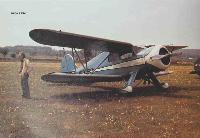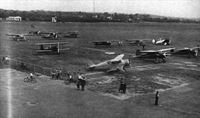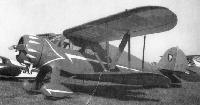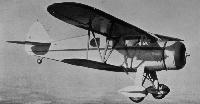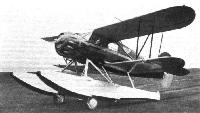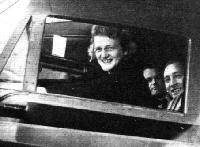
Waco. Бипланы
<...>
В 1930 году были введены трехбуквенные обозначения самолетов, в которых первая буква указывала на тип двигателя, вторая - на тип планера, а третья - на серию. В некоторых случаях добавлялись дополнительные буквы или цифры для более точного обозначения модели самолета.
В 1931 году «Waco» вышла на рынок самолетов с закрытыми кабинами, выпустив Model QDC, - четырехместный самолет с двигателем Continental мощностью 165 л. с. Решение компании оправдало себя, хотя компания продолжила и выпуск самолетов с открытыми кабинами.
<...>
В апреле 1934 года был сертифицирован кабинный биплан Model YKC, который вскоре стал самым успешным коммерческим проектом компании. Самолет оснащался новым двигателем Jacobs L-4 (225 л. с.), позже на основе его был спроектирован вариант Model ZKS-6 с двигателем Jacobs L-5 (285 л.с.), выпускавшийся до 1937 года.
В 1935 году появились новые серии четырех-/пятиместных самолетов Custom Cabin, отличавшихся увеличенными размерами и более удобными кабинами. Самым популярным был Model YOC, который сначала оснащался двигателем Jacobs L-4 (225 л. с.), но более поздний Model YOC-1 получил двигатель Jacobs L-5 (285 л. с.). Model YQC-6 был еще одним четырех-/пятиместным бипланом из семейства Custom Cabin и мог оснащаться одним из семи различных двигателей на выбор, самым мощным из которых был Jacobs L-6 (330 л.с.). Несколько машин были проданы в Канаду, в основном это были самолеты Model ZQC-6 с двигателями Jacobs мощностью 285 л. с. На некоторых самолетах были сделаны дополнительные двери, они использовались в качестве грузовых(максимальная грузоподъемность составляла 363 кг). Среди других моделей семейства - Model YQC-6, поставлявшийся в Индию с двигателем Jacobs мощностью 225 л. с. К концу 1936 года в постоянной эксплуатации находились более 1140 самолетов компании «Waco», некоторым из них было уже более 10 лет.
В 1937 году появились самолеты Model YKS-7 и ZKS-7, оснащавшиеся, соответственно, двигателями Jacobs мощностью 225 л. с. и 285 л.с. Первая модель оказалась наиболее успешной и выпускалась до 1941 года.
Два типа самолетов заказала Бразилия. Первый Model CPF 1935 года разработки использовался в качестве учебно-тренировочного. Самолет Model EGC-7 1937 года выпуска, оснащавшийся двигателем Wright R-760-E2 мощностью 320 л.с., был заказан Сухопутными войсками Бразилии (в 1938-1939 годах туда отправили 30 самолетов).
<...>
Описание:
- Waco. Бипланы
- Flight, July 1933
AN AMERICAN FOUR-SEATER
Фотографии
-
Aeroplane Monthly 1996-08 / M.Oakey - Vintage news
Регистрационный номер: NC12438 Fresno-based Alan Buchner’s immaculate 1932 Waco QDC-2 NC12438 won the prestigious Mayors Trophy at the Antique Aircraft Fly-in at Merced, California, on June 7-8, 1996 - two weeks after winning the “Grand Champion” title at nearby Watsonville.
-
Aeroplane Monthly 1991-10 / H.Levy - WACO reunion '91
Регистрационный номер: NC17701 Wayne Hayes’s hangar full of Wacos with Hayes's 1937 YKS-7 NC17701 in the foreground.
-
Aeroplane Monthly 1997-03 / J.Meadows - Doctor in the air
Регистрационный номер: CF-CCW [2] The doctor’s Waco moored at an inland logging camp - note logged slope in the background.
-
Aeroplane Monthly 1997-03 / J.Meadows - Doctor in the air
Регистрационный номер: CF-CCW [2] With temporary beaching wheels attached, the Waco is seen ashore during maintenance, probably at Vancouver, circa 1960.
-
Flight 1933-07 / Flight
Регистрационный номер: G-ACGJ [3], VH-UAX [3] This side view of the "Waco" shows the interplane strut with a wide fairing on it so arranged that it can be rotated to form an airbrake when landing.
-
Flight 1933-07 / Flight
Регистрационный номер: G-ACGJ [3], VH-UAX [3] The "Waco" has large side windows which can be opened. The clean design of its undercarriage should be noted.
-
Air Pictorial 1958-05
Регистрационный номер: G-ACGJ [3], VH-UAX [3] WACO MODEL UIC (1933). S.A.C. N. Dunmow, at present serving with the R.A.F. in Cyprus, has sent lo "Attic" this unusual photo of the only British-registered Waco Model UIC about to be off-loaded from a German vessel al Bremen in 1933. Owned by Lady Hay Drummond-Hay, this Heston-based Waco eventually went to Australia as VH-UAX.
-
Flight 1935-10 / Flight
IN NEW ZEALAND: The Wellington Aero Club's Waco cabin machine and Gipsy Moth on the tarmac at Rongotai aerodrome.
Другие самолёты на фотографии: De Havilland Gipsy Moth / Moth X - Великобритания - 1928
-
Flight 1939-08 / Flight
The scene at New Haven airport, the centre of the proceedings. This airport is on the edge of Long Island Sound and the airport manager hired machines to the entrants
-
Aeroplane Monthly 1998-12 / M.Hooks - Weekend jolly /Inter-war civil/
Регистрационный номер: PH-MAG Part of the visiting aircraft park at Heston. Visible are Hornet Moths EC-BBF and OE-DKS, BA Eagle HB-DES, Klemm KI 32 D-EREQ, Heinkel Kadett D-EQOS, Leopard Moths HB-ARI and HB-EFE, and Waco UIC PH-MAG.
Другие самолёты на фотографии: British Klemm BK-1 Eagle - Великобритания - 1934De Havilland Hornet Moth / D.H.87 - Великобритания - 1934De Havilland Leopard Moth / D.H.85 - Великобритания - 1933Heinkel He-72 Kadett - Германия - 1933Klemm Kl.32 / Kl.36 - Германия - 1932
-
Flight 1939-08 / Flight
A previous president of the New England Intercollegiate Flying Clubs, Bill Atterbury, presents the bomb-dropping trophy to one Flynn.
-
Aeroplane Monthly 1997-03 / J.Meadows - Doctor in the air
A rare shot of the Waco on wheels, with a youthful Dr Pickup standing in front.
-
Aeroplane Monthly 1998-12 / M.Hooks - Weekend jolly /Inter-war civil/
Регистрационный номер: PH-VDL Two Dutch-registered Wacos arrived; PH-VDL was a Model CUC, written off at Rotterdam’s Waalhaven airport in December that year.
-
Мировая Авиация 251
Компания «Waco» выпускала множество модификаций 4-5-местных кабинных бипланов, которые в самой компании имели общее название «Standard Cabin». На фотографии - вариант UKC-5.
-
Air Pictorial 1957-09
Регистрационный номер: VH-AAF Waco EGC-8, VH-AAF (c/n. 5051), was delivered new to Australia in 1938, and today this large five-seat biplane (Wright Whirlwind R760E-2), in green, black and gold colour scheme, still flies at Bankstown, owned by G. B. S. Falkiner.
-
Aeroplane Monthly 1986-02 / Grapevine
Регистрационный номер: VH-CGF Also at Archerfield was Cliff Douglas' recently-rebuilt Waco EGC-8, VH-CGF, in an attractive midnight blue and white paint scheme.
-
Jane's All the World Aircraft 1938 / 03 - All the world's aeroplanes
The Waco Model C Series Four/Five-seat Cabin Biplane.
-
Aeroplane Monthly 1985-09 / WACO UKC-S NC15214 /Preservation Profile/
Регистрационный номер: NC15214 [3] PETER R. MARCH'S photograph of WACO UKC-S NC15214 was taken this year. The aircraft is powered by a 220 h.p. Continental R-670 radial engine which gives a steady cruising speed of 100 m.p.h. Paul McConnell is the aircraft’s 19th owner.
-
Aeroplane Monthly 1985-09 / WACO UKC-S NC15214 /Preservation Profile/
Регистрационный номер: NC15214 [3] -
Aeroplane Monthly 1985-09 / WACO UKC-S NC15214 /Preservation Profile/
Регистрационный номер: NC15214 [3] -
Aeroplane Monthly 1991-04 / H.Levy - WACO on the brain
Регистрационный номер: NC15244 [4] Taken last summer, these pictures of Dr Bob Jaeger’s Waco YOC NC15244 show off its curvaceous elliptical wings and ample fuselage. The YOC spans 35ft 6in, is 25ft 6in long and has a cruising speed of 105 m.p.h. on 275 h.p.
-
Aeroplane Monthly 1991-04 / H.Levy - WACO on the brain
Регистрационный номер: NC15244 [4] -
Aeroplane Monthly 1991-04 / H.Levy - WACO on the brain
Регистрационный номер: NC15244 [4] -
Aeroplane Monthly 1991-04 / H.Levy - WACO on the brain
Регистрационный номер: NC15244 [4] -
Jane's All the World Aircraft 1938 / 03 - All the world's aeroplanes
Регистрационный номер: NC15710 The Wako Model S Series Four/five-seat Cabin Biplane.
-
Air Enthusiast 1972-11 / Talkback
One of the eight Lockheed 12As operated by the Brazilian Army Aviation Service. Photograph of it (c/n 1235) taken on 18 November 1939 at Afonsos airfield, Rio, against an interesting background of (left to right) a Vought V.65B Corsair, a Bellanca 31-42 Pacemaker, a Waco EGC-7 and two Vultee V-11GB2s.
Другие самолёты на фотографии: Bellanca Pacemaker / Skyrocket - США - 1928Lockheed Electra Junior 12 - США - 1936Vought O2U/O3U/V-65/V-93 Corsair - США - 1926Vultee V-11 - США - 1935
-
Air-Britain Archive 1983-04
Регистрационный номер: ZK-ALG Waco UIC ZK-ALG securely tied down at Palmerston North during the 1956 Ag-Aviation Air Pageant. The badge carries the name Northland above and Air Taxi Air Charter below.
-
Air-Britain Archive 1981-04
Регистрационный номер: NZ574, ZK-ADE A wartime shot of the Waco UIC ZK-ADE in RNZAF markings as NZ574.
-
Flight 1937-03 / Flight
PRIVATE AMPHIBIAN: After one has learnt to hold off, while landing, at about twice the height of a normal undercarriage, this Edo amphibian gear - shown fitted to a Waco - should have definite advantages. The tail of each float is hinged and sprung to take tail-down landing stresses and the whole gear weighs 175 lb more than the standard float arrangement.
-
Air Pictorial 1957-10 / Air Pictorial's photo-review
Регистрационный номер: CF-BDW Newly-painted is a rebuilt Waco ZQC-6 (c/n. 4643; CF-BDW) at Hamilton.
-
Flight 1937-04 / Flight
The American private-owner type equipped with Edo floats: a Waco - with the amphibious type.
-
Flight 1936-07 / Flight
Miss Bessie Owen, a visitor from the U.S. (not direct by air), in the cabin of her Waco.
- Фотографии

